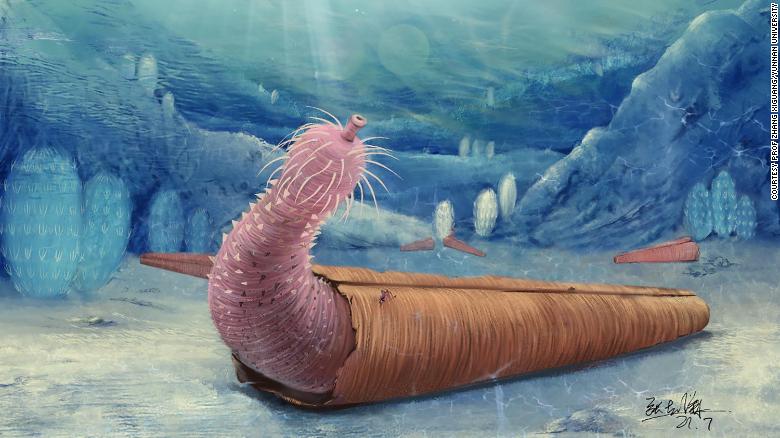
(CNN) – In the depths of the ancient seas, about 500 million years ago, folic-shaped creatures called penile worms captured hollow shells to protect themselves from predators, which is the first evidence of the behavior of crabs as is well known today.
Analysis of fossils found in the Yunnan province of southern China, dating to the Cambrian period, in which penile or priaplite worms lived like hermit crabs. The fossils preserved the soft tissues of four penile worms called eximipriapulus and objects from the conical shells belonging to the animal called holidos.
“Worms are always found comfortably within the same tiles, in the same position and orientation,” said Martin Smith, associate professor of archeology at the University of Durham in the United Kingdom. He co-authored a study of fossils published Monday in the journal Current Biology.
“The only explanation that makes sense is that these bombs are their homes, which is a real surprise,” Smith said.
Hermit behavior is believed to have formed much later, during the Jurassic period, about 170 million years ago, at the height of dinosaurs.
Behavior is one of the hardest things to discover from fossils. How did the researchers find out that the worms did not use the tiles as a temporary shelter or as a shelter from the environmental conditions that caused them to die while laying eggs?
“This is the big question we need to convince ourselves of in this study,” Smith said in an email.
“We first showed that the worms are actually inside the tiles, between the top and bottom surfaces,” he said. “It shows that biology should be responsible, not autopsy procedures.”
“Beyond this, there are two key observations: First, the worms not found in the tiles are not in the reservoir, and we expect the relationship to be temporary or opportunistic,” he added.
“Second, the size fit is consistent: worms are always found in a shell, which is large (but not large enough) to accommodate,” he wrote. “Like Goldilocks, they seem to have chosen the ‘right’ shell for themselves.”

The penile worm Eximipriapulus lives in a hollow shell.
Surprises of the Cambrian period
In the days when these worms lived, the world was a very different place. Continents stretch along the equator, and Smith said there is not much living on Earth other than “microbial sludge.” However, life in the oceans began to converge.
“As soon as the first complex (marine) animals appeared, it was surprising that we began to see complex and dangerous ecologies often associated with very young geological periods,” he said.
The researchers concluded that predators of this era should be abundant and aggressive, forcing worms 1 to 2 centimeters long and one string wide to take refuge in hollow shells.
Although their findings are based on a small number of fossil specimens, this type of shelter behavior – which researchers call the “modern way of life” – reinforces the growing sense of animal behavior and the ecosystems of this era as “more contemporary”. More character than is traditionally considered. “
According to the document, hermit behavior has evolved in a variety of animals, including hermit crabs, some other crustaceans and various types of sea worms.
Currently, penile worms are only found in environments where it is difficult to establish predators, Smith said. Some are small and live between individual sand grains. Others live in foul-smelling, low-oxygen and toxic waters. And they do not take refuge in bombs.
“No one is a ‘saint’. One of the reasons why our results are so surprising is that we often think that evolution is always moving in the direction of creating problems.





